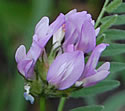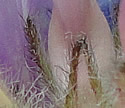Astragalus agrestis (Field Milkvetch)
| Also known as: | Purple Milk-vetch |
|---|---|
| Genus: | Astragalus |
| Family: | Fabaceae (Pea) |
| Life cycle: | perennial |
| Origin: | native |
| Habitat: | sun; moist soil; low areas of meadows and prairies, along shores |
| Bloom season: | June - July |
| Plant height: | 6 to 12 inches |
| Wetland Indicator Status: | GP: FACU MW: FACW NCNE: FACW |
| MN county distribution (click map to enlarge): |  |
| National distribution (click map to enlarge): |  |
Pick an image for a larger view. See the glossary for icon descriptions.
Detailed Information
Flower: 

![[photo of flowers]](/udata/r9ndp23q/pd/astragalus-agrestis-11-17-t.jpg) Light purple pea-like flowers in a round to ovoid cluster at the tip of a stalk emerging from a leaf axil. Clusters are up to 1 inch wide by 1 inch tall; the stalk shorter or longer than the associated leaf. Flowers are ½ to ¾ inch long, the outer flowers blooming first. The calyx holding the flower is densely covered in long gray to black hairs.
Light purple pea-like flowers in a round to ovoid cluster at the tip of a stalk emerging from a leaf axil. Clusters are up to 1 inch wide by 1 inch tall; the stalk shorter or longer than the associated leaf. Flowers are ½ to ¾ inch long, the outer flowers blooming first. The calyx holding the flower is densely covered in long gray to black hairs.
Leaves and stems: 

![[photo of leaves]](/udata/r9ndp23q/purple/field-milkvetch_0610_135513-t.jpg) Leaves are compound in groups of 13 to 21, up to 4 inches long and 1½ inch wide, alternately attached. Leaflets are up to ¾ inch long, lance-elliptic to oblong, toothless with sparse to dense hairs on both surfaces. Multiple stems are smooth or slightly hairy, scattered, emerging from a small crown or from underground rhizomes.
Leaves are compound in groups of 13 to 21, up to 4 inches long and 1½ inch wide, alternately attached. Leaflets are up to ¾ inch long, lance-elliptic to oblong, toothless with sparse to dense hairs on both surfaces. Multiple stems are smooth or slightly hairy, scattered, emerging from a small crown or from underground rhizomes.
Notes:
A species moist prairies at cooler latitudes, Field Milkvetch is limited to Minnesota's western counties. The flowers are very similar to Prairie Milkvetch (A. adsurgens), which has a far denser stem cluster. Field Milkvetch has a more spidery appearance.
Native Plant Nurseries, Restoration and Landscaping Services ↓
More photos
Photos by K. Chayka and Peter M. Dziuk taken at Strandness Prairie in Pope County.
Comments
Have you seen this plant in Minnesota, or have any other comments about it?
on: 2014-07-05 16:26:59
My search included Wikipedia, plants.usda.gov, bellmuseum.umn.edu, finally landing at minnesotawildflowers! Bingo! I found your images and info most useful in identifying a big patch of purple blooming in the nearby lake meadow: Astragalus agrestis--Field Milkvetch! Biggest patch I have ever seen in that meadow. Not sure if it was part of an NRCS set-aside planting in the past decade or if it the seed was already in the soil bank, but which ever, it's lovely. Thank you Katy and Peter!
on: 2018-07-09 09:50:12
Field Milkvetch plant: Is this type of plant toxic? the reason I am asking is that the root can be used as nutritional supplement? thanks!







 Field Milkvetch plant
Field Milkvetch plant closeup of hairy calyx
closeup of hairy calyx